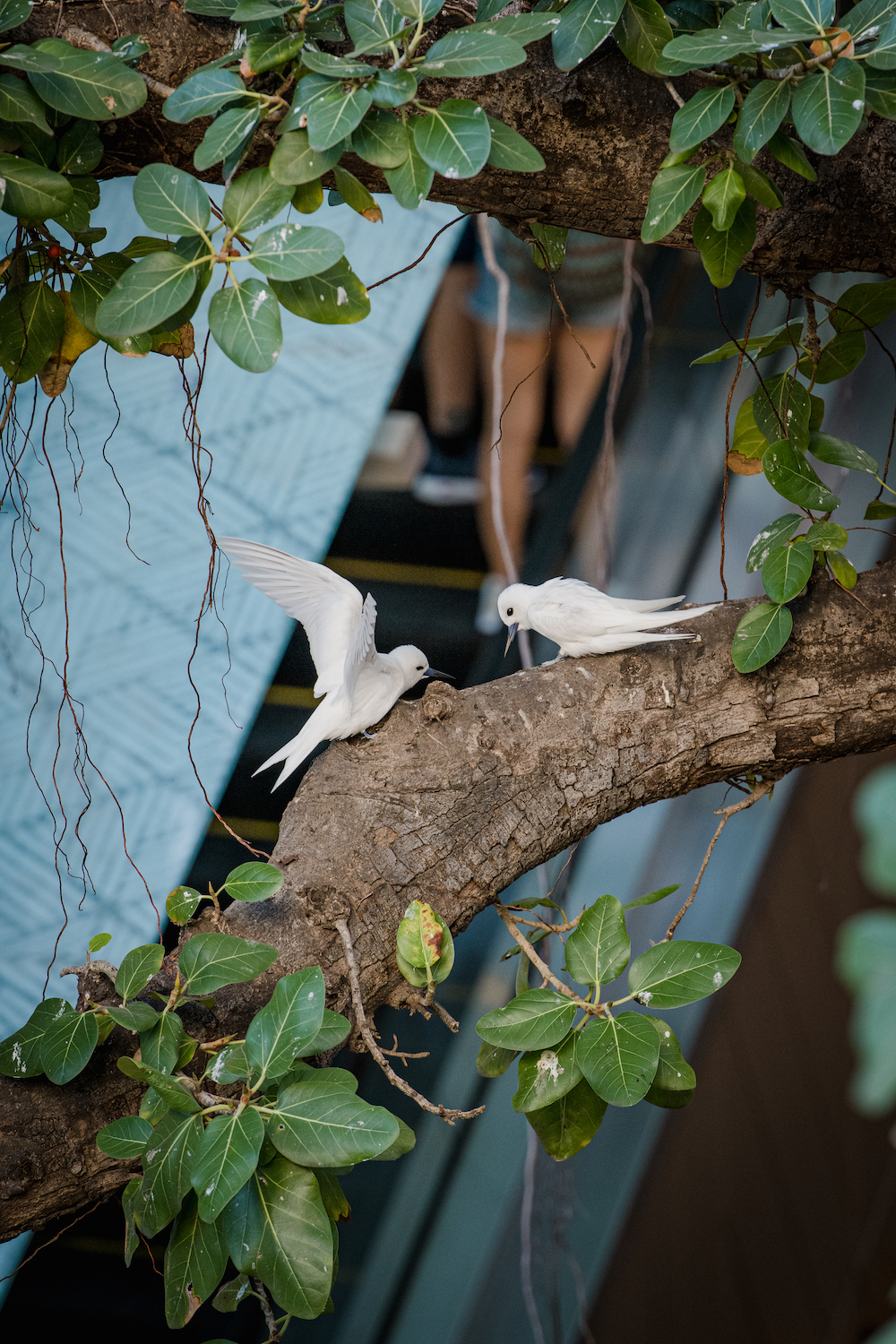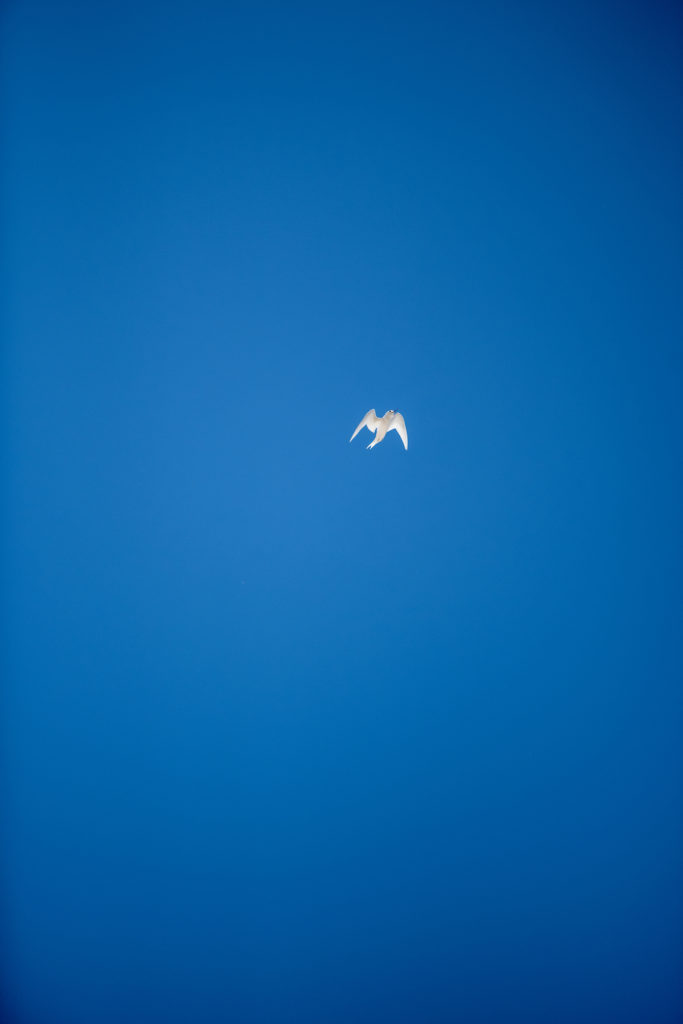
The Bird of Kū

Learn about O‘ahu’s city-dwelling manu-o-Kū (white tern) and the conservationists dedicated to observing, protecting, and raising awareness about this native seabird species.
✏️ TRACY CHAN
📸 CHRIS ROHRER
オアフの都市に生息する愛らしい在来種の海鳥、マヌオクー(シロアジサシ)とその観察と保護、認知度向上に取り組んでいる自然保護活動家について学びましょう。
It’s no wonder Honolulu’s resident seabirds earned the nickname “fairy terns”—it’s a treat to see them performing an aerial ballet in the sky over the city. But the indigenous bird has another name in the Hawaiian language: manu-o-Kū, meaning “the bird of Kū.”
Kū, the god of war, is one of the four most powerful gods in Hawaiian mythology. The tern, with its white body and black rings around its eyes, is considered sacred to Kū, who is often represented as a feathered being. Linguists also believe the name manu-o-Kū could have been derived from ʻohu, the Hawaiian word for fog, mist, or cloud.
In April 2007, manu-o-Kū was designated the official bird of Honolulu, partly due to its love of urban centers, but also for its importance to Polynesian voyagers. Because of the bird’s habit of flying out to sea in the morning to feed and returning to land at night, traditional Hawaiian seafarers and navigators have long looked to manu-o-Kū to guide them to land.. The little birds, which mate for life, catch small fish or squid (sometimes stacking them in their beaks if there is a chick to feed) and bring them back to the tree in which they’ve made their home.
While white terns don’t make nests, they love a knotty tree offering wide branches and forks for shelter. The historic banyan tree at International Market Place has long been a preferred residence for white terns and remains one of the best spots on island for people to view them. “The banyan tree at the International Market Place is Exhibit A in what makes Honolulu’s terns so unique,” says Rich Downs, director of Hui Manu-o-Kū, a citizen scientist group formed in 2016 that is dedicated to observing, protecting, and raising awareness about the birds. “They prefer to breed where the highest population of humans are, and trimming the trees makes it easier for them to breed.”

According to Downs, manu-o-Ku prefer nesting in trees that have been trimmed because the resulting scar tissue forms a cup shape perfect for holding a tern egg. Of the nearly 1,300 trees that the group monitors on O‘ahu, International Market Place’s famed banyan tree has the highest number of documented nesting sites: 23 in total. Since white terns tend to return to a spot where they’ve successfully fledged a chick, it’s not uncommon to see the branches of the giant banyan all aflutter with snowy white wings.
Steve Nimz, an arborist who has spent much of his career working on banyan trees, has been caretaker of the banyan tree at International Market Place for the last 50 years. “The tern population has definitely increased over the last five years,” Nimz says. He explained that before the trees are pruned, he and his crew identify all the tern nests and verify they’re all still there when pruning is done.
“While we were doing construction [on the new International Market Place], there was a tern on a second-floor branch that was sitting right above our heads the entire time,” Nimz says. He called his daughter, an ornithologist, and asked her why the bird didn’t just move to another spot. She said, “That bird is nesting in the same place it always has, it just went right back to its old nesting spot that would normally be 25 to 30 feet off the ground.’”
Nimz and his crew put up signs and took other precautionary measures to try and keep the tern, nesting just a few feet over the heads of the construction workers on a busy walkway, from being disturbed. “What I found funny was that all [the workers] would…look to see whether the egg had hatched, or if the chick had gotten bigger, and they’d report daily [on the progress of the] chick,” he says.
“They’re a very understudied bird,” Downs says. “Here we have a unique opportunity to study them without having to leave Honolulu or Waikīkī. They haven’t always been on Oʻahu, and we’d like to understand what attracted them to this particular location and make sure we continue to make it an appealing place.”

For more information, inquiries about monthly tern-watching tours, or to find out how you can volunteer as a citizen scientist to help collect data on the white terns, visit the Hui Manu-o-Kū website at whiteterns.org or email [email protected].
More on Honolulu’s white terns:
• Terns are very efficient fliers and can stay aloft with minimal effort. They’re known to travel hundreds of miles from shore.
• DNA research suggests that Honolulu’s tern population, like Hawai‘i’s early inhabitants, hail from several different places in the Pacific.
• Manu-o-Kū lay only one egg at a time. If a mated pair successfully hatch a chick, chances are high they’ll return to the same spot the following year.
• Looking for a tern nesting site? Check the ground for pure white droppings. Since manu-o-Kū only eat fish, their droppings don’t contain seeds and other matter found in most bird droppings.








